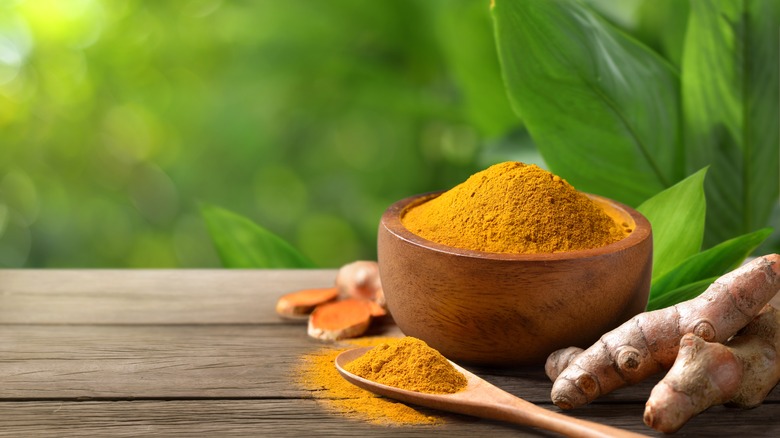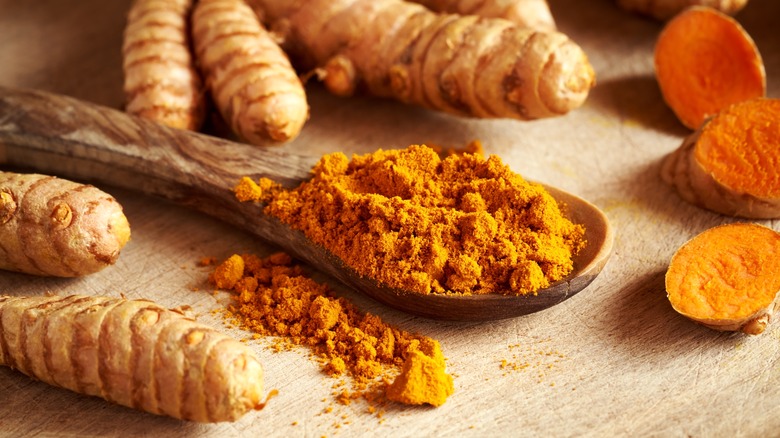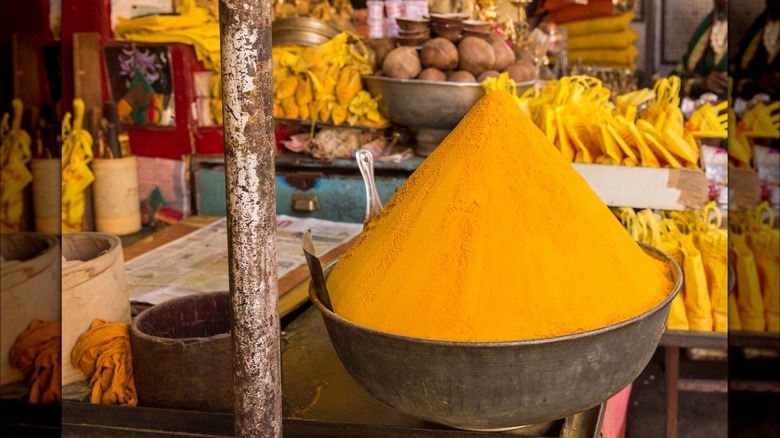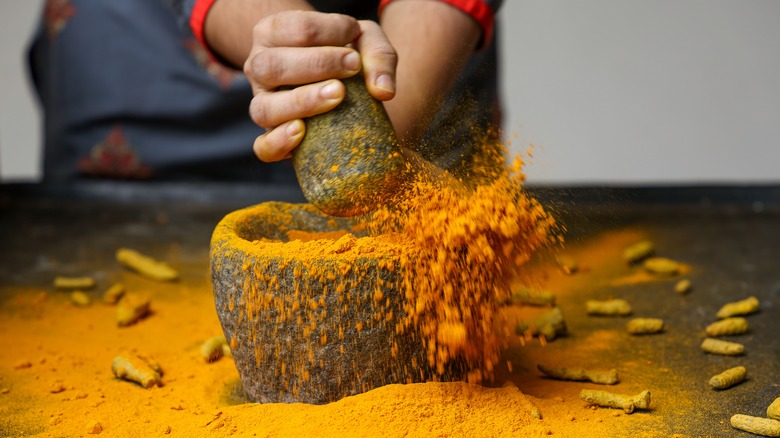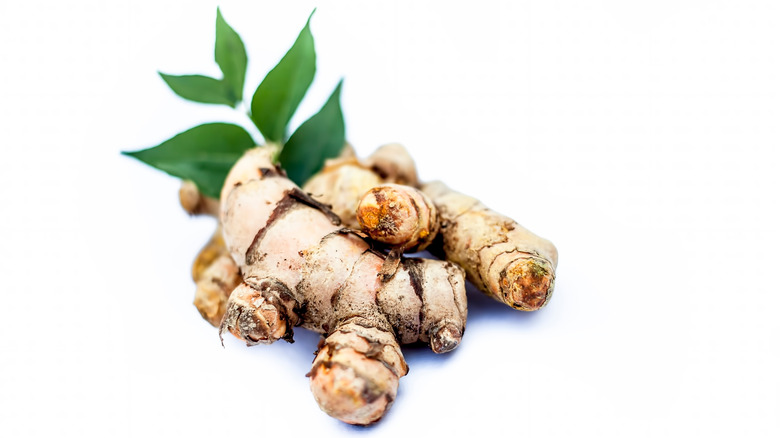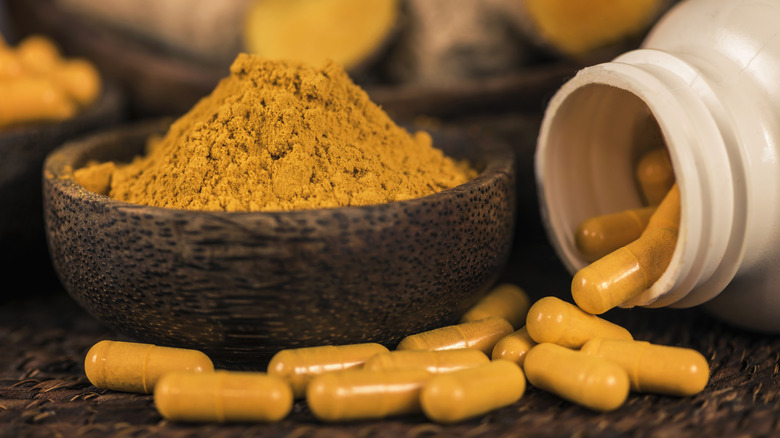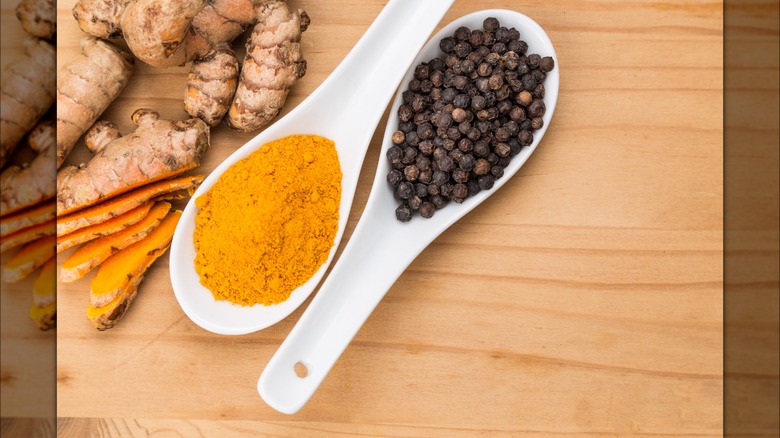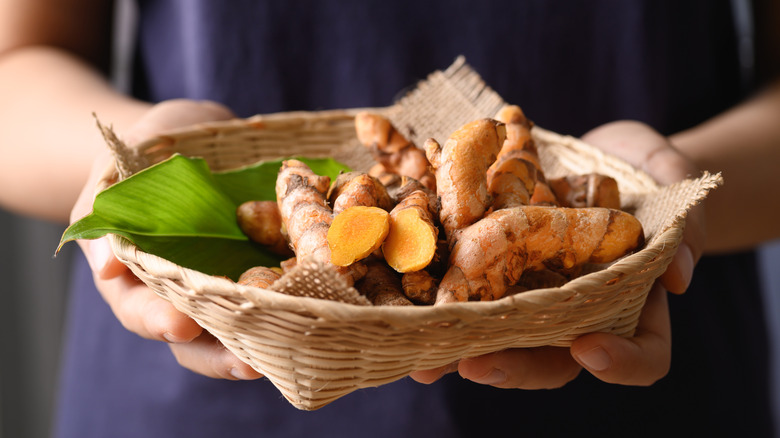Turmeric Vs. Curcumin: What's The Difference And How To Use Them
If you've seen turmeric and curcumin on store shelves, you may have wondered, "What's the difference?" They're both bright yellow spices, right?
Recipes will often use them interchangeably to add a warm, earthy flavor, and they will frequently make appearances in many Indian dishes, particularly curries. And these substances are also what give mustard its characteristic color. But, while you probably know how turmeric and curcumin are used, you might not understand exactly what they are.
They aren't merely two names for the same thing. There are actually significant differences between the two spices, as well as health benefits and drawbacks that separate them. To fully grasp these differences, you must first know what each one is and how it's made.
So, if you want a better understanding of these two foods, keep reading. We'll deep dive into all the spicy details of turmeric versus curcumin and the best ways to use each of them.
The difference between turmeric and curcumin
Turmeric is the name of a root vegetable, while curcumin is a chemical compound found in this plant. You'll see both in powdered form as spices. And as spices, they look and taste pretty much identical. As such, the terms are often used interchangeably. But are they the same? Not exactly.
As we mentioned, turmeric is a root vegetable. Its Latin name is Curcuma longa — this sounds an awful lot like curcumin which can make things a bit confusing — but bear with us. Turmeric comes from the ginger family, Zingiberaceae, and the plant can grow just over 3 feet high and blooms yellow and white flowers. However, turmeric is a tuber vegetable, meaning we eat its underground roots. When sliced open, these roots resemble their cousin, ginger, but with a deeper yellow-orange hue.
Curcumin, on the other hand, isn't a plant at all. It's a compound found within Curcuma species, namely turmeric. It's full of health benefits and gives turmeric its bright yellow color. In fact, most of the health benefits of turmeric are attributed to curcumin. Since people want more of this antioxidant-rich compound, and because true turmeric powder only has an average of 3.14% curcumin, they extract curcumin from the turmeric plant.
In summary, when you see turmeric spice, it might be made from the whole root. But, when you see curcumin on the shelf, you're getting solely the processed compound.
A brief history of these golden spices
Turmeric and curcumin are all the rage in health communities and are known as natural anti-inflammatories. But, while they're currently revered for their culinary and medical purposes, the benefits of turmeric are nothing new.
The plant has been used for over 4,500 years, with some of the earliest evidence dating back to 2500 BCE near New Delhi. Since the turmeric plant grows naturally in the tropical climate of Southeast Asia, it's no surprise it became popular here first. Vedic cultures incorporated it into their cooking and lifestyle practices early on. And by 500 BCE, it was an integral part of Ayurvedic medicine. This golden child of Ayurveda was used for everything from congestion to skin diseases. Ancient Indians even used its bright hue to dye jewelry, textiles, and clothing.
These cultures paved the way, and turmeric likely reached the Western world through trade routes and British colonization. The British Library even houses a 1747 cookbook raving about turmeric's healing properties: "It is exceeding pleasant and healthful — renders the stomach active in digestion — the blood naturally free in circulation — the mind vigorous, and contributes most of any food to an increase of the human race."
But, although turmeric has been around for ages, curcumin is a much more recent discovery. It wasn't until the early 1800s that the compound was separated from the plant. And today, scientists continue to research curcumin independently, learning about its health benefits and improved extraction methods.
Different forms of turmeric
Have you ever seen turmeric in its root form? You may have passed it in the supermarket — or mistaken it for another root vegetable. However, not all stores sell turmeric in root form. You'll likely find this fresh, raw vegetable at specialty produce or nutrition markets.
On the other hand, turmeric powder is everywhere. As you read this, you probably have turmeric powder in your spice cabinet. This powder is made by drying and grinding the root (aka rhizome) into a fine dust. However, extraction takes this one step further. It's processed using chemicals or a solvent to extract the best components from the root. Therefore, curcumin is an extract of turmeric. You'll also find turmeric powders and extracts in pill form that health-conscious consumers take as supple ments. And lastly, you might even come across turmeric essential oils, which are distilled from the powder and commonly used to enhance skin health.
While the amount of curcumin in ground turmeric hovers around 3%, extracts contain up to 95%. So if you're aiming for the health benefits associated with curcumin, you're better off going with a high-quality curcumin seasoning or supplement.
What else has curcumin?
Turmeric and curcumin are so intertwined it's hard to imagine one without the other. So, this made us ponder what else could possibly contain curcumin.
Regarding plants, turmeric is the most well-known source of curcumin. However, this earthy compound is also found in mango ginger. In the scientific world, mango ginger is known as Curcuma amada, and judging by its name, it's not surprising it has curcumin. The mango ginger plant is a relative of turmeric, and the root looks almost identical to the untrained eye. But as its name suggests, its flavor has a hint of mango. Mango ginger is often used in India for pickles or chutneys, but you probably won't readily come across this root in the U.S.
Suffice it to say, there aren't many plants that have curcumin. But, when it comes to spices, this golden goddess is quite popular. It's used in several spice blends, including curry and Moroccan spices. Curry powder mixes turmeric or curcumin with coriander, cumin, and chili pepper, and gives curries their signature color and flavor. Moroccan spice combines turmeric or curcumin with coriander, allspice, paprika, ginger, cinnamon, and cloves for a sweet-and-savory blend.
Which is healthier: turmeric or curcumin?
Turmeric and curcumin are touted as superfoods and revered for their anti-inflammatory effects. But, is it all just hype, or do these spices carry real health benefits?
According to a study done by Nutritional Journal, participants that consumed turmeric or curcumin showed improvements in their overall blood lipid levels, which include LDL, HDL, and total cholesterol. These levels are considered a driving factor in heart disease, which the WHO reported as the leading cause of death worldwide in 2020.
So if you're hoping to improve your cholesterol, you might want to sprinkle these spices over your meal. But, if you're deciding between the two, there are some additional things to consider. For one, turmeric has high levels of oxalates, while curcumin has little to none. Oxalates are natural — although toxic — compounds found in many plants, including spinach. They can contribute to the formation of kidney stones and are also considered an anti-nutrient because they block the absorption of other nutrients (per Nutrients). However, people consume small doses of natural plant toxins all the time without issues. Like most foods, it depends on individual tolerance.
When eating turmeric, you're bound to get some of the benefits of curcumin. However, turmeric might have benefits aside from this one active compound. A study published in Molecular Nutrition and Food Research found that turmeric reduced tumor growth more than curcumin alone. And, since curcumin isn't the only compound found in turmeric, perhaps the other attributes of turmeric are contributing in ways we don't fully understand just yet.
Maximizing the health benefits of curcumin
Curcumin might be packed with health benefits, but those benefits are useless if we can't actually absorb the stuff. And sadly, curcumin is notorious for having low bioavailability. This is to say; the body has trouble absorbing the compound into the bloodstream so that it can have an active effect. Luckily, there are tricks to maximizing the health benefits of curcumin.
Curcumin is a fat-soluble compound. When consumed with fats, it's more likely to dissolve, enhancing absorption. So if you're using it as a spice, eat it alongside fats like butter, oil, nuts, or seeds. And, if you're taking curcumin as a supplement, have it with a tasty meal like an avocado salad.
Another easy trick is to combine curcumin with black pepper. Just as curcumin is turmeric's active compound, peperine is black pepper's active compound. According to Foods, when peperine is combined with curcumin, it improves absorption by up to 2000%. Not only does this dream team increase bioavailability, but it's also delicious. Curcumin adds an earthy edge to savory dishes, while black pepper gives a hot, piney flavor. They're the perfect additions to stir-fries, soups, or even fresh dips.
But do they taste the same?
By now, it's apparent that turmeric and curcumin are two different things. Curcumin is responsible for turmeric's bright color and contributes to its intense flavor. But, do these two spices taste the same? Truthfully, in powder form, they're almost indistinguishable.
So, if it's the flavor you're after, you can use turmeric or curcumin. Bear in mind; a little bit goes a long way with these spices. Raw turmeric or curcumin powder can be quite pungent, but the flavor softens when cooked. So don't be off-put by the smell of the ground powder. When cooked into meals, you might thoroughly enjoy it. However, we still wouldn't recommend using it on its own. A dish seasoned solely with turmeric can taste overly earthy and bitter. It's best to combine it with salt, pepper, or other herbs and spices. A squeeze of lemon also adds some welcomed acidity. And, if you're using it in a turmeric smoothie, add something sweet to balance its strong savory qualities.
Best ways to use turmeric root
In its raw form, turmeric resembles ginger root and can be used similarly. So, if you're looking for a healthy tonic, go wild with teas, drinks, and smoothies. One Reddit user describes putting turmeric root to good use: "[I] make a turmeric, ginger, lemon, honey drink from it. It's really tasty and is a good way to use up fresh turmeric." And, if you're brewing kombucha drinks, add it to a second fermentation. Sliced turmeric root contributes a rich yellow color to this bubbly beverage. Toss in some berries, and you have a healthy summer refreshment.
Alternatively, turmeric root can liven up savory dishes like soups, stews, or stir-fries. In a marinade, it'll impart just the right amount of bitterness. If you prefer to eat the root, chop or grate it well before adding it to dishes. Much like ginger, it has a tough, stringy texture, so you'll want to ensure it's cooked till soft. Those soft slivers of turmeric will add a burst of flavor and color to any meal.
Best ways to use turmeric or curcumin spices
In the spice world, there's nothing quite like turmeric and curcumin. These spices add a vibrant yellow color similar to saffron. However, the flavor is much stronger. And, since these spices taste almost indistinguishable, you can use them interchangeably.
Turmeric is a prime player in Persian and Indian cuisine. Its bitter earthiness works well in meat stews, curries, and rice. And, if you're making salad dressing, sprinkle some turmeric in to brighten things up.
However, don't feel confined to solely savory foods. You can use it to create golden granola, cookies, muffins, and more. Turmeric can also be used to make a mean cup of golden milk — which is just as it sounds. This golden elixir consists of milk, turmeric (or curcumin powder), ginger, cinnamon, a sweetener, and of course, coconut oil and black pepper to help you reap all of turmeric's health benefits.
How to store turmeric and curcumin
To preserve the quality and flavor of your food, you need to store it right. But, while it may not be as obvious, it's also important to think about how you store tuber vegetables and spices.
Since fresh turmeric root is raw, it has a much shorter shelf-life than its powdered form. According to Low Histamine Eats, fresh turmeric can be kept in the fridge for up to two weeks and in the freezer for up to 12 months. If portions start to mold, simply cut them off. But if you notice any significant changes in smell, color, or consistency, toss it.
Turmeric and curcumin spices have been dried and processed, so they'll last much longer. Still Tasty reports that they can last up to three or four years when stored properly. While they may technically be safe to consume indefinitely, the nutritional value and flavor profile begin to deteriorate around this time. Your best bet is to keep it in a cool, dry place away from direct sunlight. After all, if you're a turmeric fan, it's not just the beautiful golden color you're after — but the bold flavor and powerful health properties.
